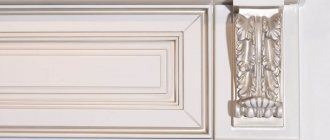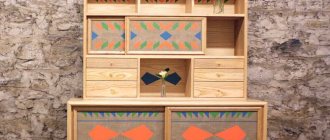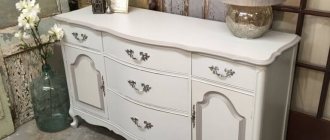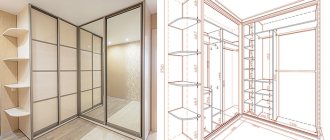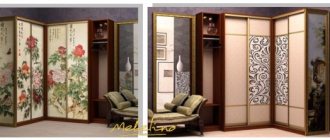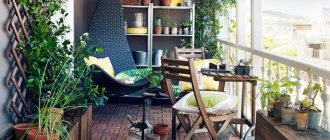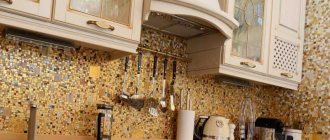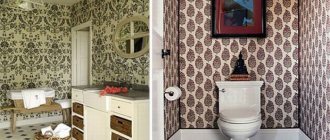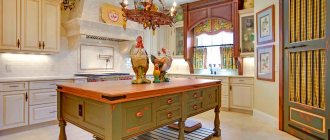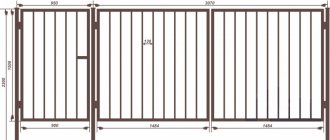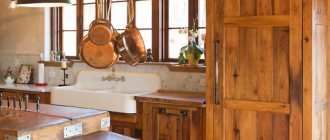A correctly chosen buffet in the kitchen interior will not only be a comfortable and practical piece of furniture, but will also add sophistication to the interior. This article will discuss what a kitchen buffet can be and how to choose it.
Choosing a cabinet for dishes is a very important detail when arranging a kitchen area.
Buffets for the kitchen (photo selection)
To imagine what a particular kitchen sideboard will look like, you can look at a selection of photos.
A kitchen cabinet is not only a container for all kinds of utensils, but also one of the main interior accents.
A selection of old but beautiful options
Exquisite models with a touch of antiquity can be very aesthetically pleasing. They fit especially well into classic, French or English interiors.
A small wall-mounted kitchen cabinet can easily accommodate a standard set of dishes for three or four people.
Modern
Although buffets “came down” to us from the 17th century, they can also be modern. You can see what modern kitchen sets with a buffet will look like in the photo.
A hanging cupboard with transparent doors made of glass or plastic looks very nice.
What is a buffet?
In the usual sense, a buffet is a cabinet in which dishes, kitchen utensils and textiles are usually stored. Often a buffet may have glass inserts instead of doors. As a rule, the appearance of this piece of furniture is very laconic and does not differ in the abundance of decorative elements. Otherwise, the models can be very diverse in design, location and number of separate storage compartments, and sizes.
The buffet has a rather attractive and original appearance, but its dimensions leave much to be desired.
Design features of the buffet
Structurally, the buffet consists of three sections:
- upper;
- average;
- lower
Upper section of the cupboard
The upper part of the buffet is used to store dishes and utensils that are not used often - for example, sets for guests, wine glasses, glasses and expensive services.
As a rule, the upper shelves of such a cabinet are covered or left open altogether - thus, the dishes can serve a decorative role, but at the same time are protected from dust, moisture and grease.
Middle section
The middle section of the buffet is represented by pull-out drawers for storing cutlery and other useful items. In sideboards they are located immediately under the upper compartments. In a traditional buffet, the upper and lower sections are separated by a niche with a tabletop. It is used for frequently used dishes, vases with sweets, fruits or flowers.
Buffets often use retractable tabletops - they are very convenient for arranging the necessary utensils and performing other work processes.
Buffet base
The lower part of the buffet consists of large compartments with shelves, closed with opaque facades. They are used to store large and heavy items - pots, pans and small household appliances.
What is the main difference between modern buffets
The buffet acquired its standard appearance back in the 17th century and has not changed much since then. It is this version of the appearance that has become the most convenient, practical and at the same time aesthetic.
The scope of the buffet is in kitchen-living rooms and large dining rooms.
Modern models are not very different from analogues of other eras, but today it is less common to find models with elaborate design and a lot of decor. Also, in many modern variations there is no clear division into parts, and the facades are a single element.
It is difficult to imagine another piece of furniture that could give the interior as much comfort and warmth as a kitchen buffet.
Types of buffet service
The theme of a buffet or buffet is not something new for the global hotel business, but today it is professionally practiced in only 25-30% of accommodation facilities. Therefore, we think it will be useful to refresh the information on the pages of our publication.
We offer our readers material for students of one of the trainings, which was conducted by the German-Ukrainian Hospitality Center as part of improving the quality of preparation of hotels and restaurants in host cities for Euro 2012. To the training materials presented by Mr. Paul Kanwar, we added a number of comments from experts from the editorial staff of the Hotel and Restaurant Business magazine. Moreover, in the author’s text, instead of the usual phrase “buffet”, we will use the term “buffet”, which is widely used in European culinary practice.
The concept of "BUFFET"
A buffet is a special way of serving food. Instead of a standard set of dishes (appetizer, salad, main course, dessert) that are served on the table for the guest, in buffet service these dishes are offered simultaneously on separate tables or special buffet counters. Thus, the guest has the opportunity to self-service according to his preferences.
A distinction is made between a cold buffet and a warm buffet: a cold buffet provides for the serving of cheese, sausages, fish, salads, pastries, butter, small dishes and various desserts; warm buffet - in addition to all the above dishes, soups, various meat and fish dishes, as well as a number of side dishes are served.
In the modern restaurant business, buffet service became especially popular in the United States in the 70s of the last century, when the development of chains of buffet restaurants began, where for a fixed fee the client had the opportunity to eat until he was completely full. And if we talk about history, the buffet with counters as a service solution was invented in the 17th century, and at the end of the 18th - beginning of the 19th century in France, Napoleon introduced the fashion for quickly eating food while standing (“food that is taken with the hands”) at the top of society.
Buffets are becoming increasingly popular with consumers and are an important marketing tool for many gastronomic businesses. The main feature from the point of view of the economy of the restaurant is precisely that with such service the client is offered a certain set of dishes at a lump sum (total) price.
Types of BUFFETS
There is a fairly wide range of buffet services: permanent stationary buffets that operate throughout the entire period of service with a constant assortment. There are also themed buffets that offer specific types of dishes, but the choice of dishes can be very limited. There are also so-called “flying” buffets, where ready-made dishes are served on trays by waiters and each client can take exactly the dish he likes. This type of buffet is suitable for events taking place in limited areas or when organizing impromptu events.
The restaurateur must understand which type of buffet is best suited for a specific target audience - a permanent stationary buffet, a themed holiday buffet, a buffet for breakfast, lunch or dinner, a buffet, a specialized buffet for promotional events and sales, or a “flying buffet”.
Of course, depending on the type of buffet, the preparatory measures for setting up a buffet vary very seriously, requiring a different number of waiters and a menu that differs in nature.
Economics of a buffet, features of guest service. The establishment of a buffet as a marketing tool is of great economic importance for gastronomic production. Buffets are becoming more and more popular with consumers, and menus are becoming more and more competitive in the market.
A buffet requires significantly less maintenance costs than traditional food service, since guests are mainly served themselves. The staff should only add those dishes at the counter that are more popular, serve drinks if necessary and clear away the dishes - this is a classic approach, for example, for breakfast, lunch, dinner in a hotel restaurant. The progress of the buffet is absolutely clear, the consumable part is clear and specific.
Every guest hopes for the presence of professional and competent staff who will make his stay in the restaurant more enjoyable and guarantee a normal level of service. Of course, there are different types of guests: some strive to eat tasty and economically, others are accustomed only to the best and pay little attention to price. The latter usually order fresh juices and coffee specially brewed for them for breakfast, and incentivize the waiters with tips.
Guests expect service from competent staff who can always help navigate the buffet menu and, taking into account the special dietary requirements of individual visitors, provide explanations about the ingredients of the dish. It is clear that only an employee who is well acquainted with all the buffet’s offerings can give the guest sound advice. Therefore, serving guests with qualified and trained staff is a prerequisite for the successful operation of the establishment.
In addition to the buffet offerings at a lump sum price (for one guest), it is also necessary to provide the possibility of additional choice of dishes so that guests can eat and drink what they like and as much as they want without restrictions. At the same time, of course, high-quality drink service is one of the important economic factors.
The economic requirements of the institution within the framework of the price-service relationship must be adjusted to the expectations and desires of the guests. For the price that the guest pays, he should receive a set of services that meet his expectations, which encourage him to return to the establishment again. A satisfied guest is one of the most important marketing tools; he not only visits the establishment more often, but also recommends it to other people. Hence - more visitors, more work, more profit.
Let us repeat that there are many concepts and options for arranging buffets. This could be a format where champagne is served with or without snacks; a buffet serving canapés that are eaten with the hands; “standing” buffets, where small sandwiches, cold and or hot dishes are served; buffets with the usual order of dishes (appetizer, main course, dessert); buffets with or without drinks (espresso coffee only); bars with or without seating.
It is necessary to clearly understand the client's needs and organize the proposal in accordance with the budget of funds and time, selecting and combining appropriate options to achieve maximum effect.
Festive buffets are held mainly with the organization of seating for guests. We are talking about corporate events (celebrating company anniversaries, celebrating Christmas holidays) and family celebrations (birthdays, weddings).
When arranging stationary holiday buffets, it is important to maintain an appropriate distance between tables so that guests do not feel limited in space and discomfort.
Buffet for breakfast
Breakfast buffet service is the most common in the hotel industry. The choice of menu depends on the class of the hotel and can sometimes be limited to only tea, coffee, several types of cereals, bread, cheese, butter, and jams.
But in 4-5 star hotels, the concept of a normal buffet means offering hot dishes, omelettes with bacon, sausages, broths, etc., a wide selection of fruits. It may be quite natural to offer champagne for breakfast, especially on weekends.
All employees must clearly understand their tasks and perform them at the proper level. Cleanliness, preparation of tables, correct placement, clear distribution of responsibilities, rational arrangement of the buffet, preparation of coffee are important prerequisites for the successful operation of the buffet and the satisfaction of customer requirements. At the same time, the entire shift both in the kitchen and in the hall is equally responsible for proper service.
Absolutely everyone, from the director to the waiter, should understand the importance of breakfast. In the mentality of many foreign guests, breakfast plays an important role and it determines how the day will turn out. Breakfast is an important component of the overall image of the hotel, no less than the interior of the lobby.
Final clause
Today, buffets are a very common and fashionable format for catering. A properly developed buffet concept, taking into account its intended purpose and target groups of visitors, makes it an important marketing tool that can bring big profits.
The variability of proposals is unlimited, therefore, depending on the occasion, trends, season, it is possible to develop an appropriate concept for its holding.
The costs of running a buffet are lower, since the guest serves himself. The main tasks of a gastronomic enterprise are cleanliness, correct menu formation, reasonable arrangement of serving tables, placement and replenishment of buffet dishes, serving drinks and cleaning.
Buffet patrons should be able to choose the food and drinks they like, take extra portions if necessary, and eat in peace and comfort. Fast service when ordering drinks increases the level of comfort of guests and also increases the turnover of the establishment.
Additional Information
The term “buffet” took root only in the Russian and Ukrainian languages. In Europe and the USA, where these democratic food formats were born, as well as in Asia, where they not only successfully took root, but also received a new impetus for development, this type of service was originally called buffet (“buffet”).
In Sweden itself, this format of serving dishes is called smorgasbord, that is, “sandwich table”. Sandwich in the sense that the visitor can independently create a “menu” of his sandwich from a set of different products that (which is very important) do not spoil or lose their taste over time.
Another feature of the formation of this style of serving dishes is associated with the mentality of the inhabitants of Scandinavia - reasonable self-restraint, based on certain Puritan approaches of the Protestant faith and honesty towards society even in the absence of control. We read Alexander Kuprin’s travel notes about Finland at the beginning of the 20th century: “The long table was laden with hot dishes and cold appetizers. All this was unusually clean, appetizing and elegant. There was fresh salmon, fried trout, cold roast beef, some kind of game, small, very tasty meatballs and the like. Everyone came up, chose what he liked, ate as much as he wanted, then went to the buffet and, of his own free will, paid exactly one mark thirty-seven kopecks for dinner. No supervision, no mistrust. Our Russian hearts, so deeply accustomed to the passport, the plot, the forced care of the senior janitor, to general fraud and suspicion, were completely suppressed by this broad mutual faith.”
The buffet format, by the way, was very common on the railway and began to take root even in Russia - it was often offered by establishments at train stations, since in the limited time the train stopped it was quite difficult to individually serve a large number of customers - it turned out that it was much more economically profitable to charge them immediately a fixed fee for the opportunity to take anything from the counter, and as much as you want, of course, within the framework of the proposed menu.
Speaking about the history of the development of a buffet or buffet, it is probably worth highlighting two points. The first is, in fact, the peculiarity of serving and consuming dishes, which has been practiced for quite a long time in rich houses. The second is an economic approach to catering, when for a certain amount you can eat to your heart's content. This determined its popularity, so to speak, in the mass consumer segment. For example, for three kopecks the client was offered an unlimited amount of cabbage and cranberries.
"Hotel and restaurant business"
Types of buffets by style
In stores you can find options that differ in stylistic orientation.
Modern
Such models are laconic, not overloaded with decor and multifunctional. A modern-style buffet can be equipped with a tabletop, which can become a work area or a place to place a laptop and other equipment.
This furniture is installed not only in the dining room or kitchen, but also in the living area of modern residential premises.
Provence
Products in this style are imbued with French chic. They are simple and elegant at the same time. The predominant color is white, light aging of surfaces is allowed.
This attribute represents the warmth of a home and offers numerous possibilities for its execution in different styles.
Modern
This design is distinguished by clear and strict lines. As a rule, Art Nouveau products are made from artificial materials.
This model is very convenient, as it holds a lot of different dishes and is very beautiful.
What is good about a buffet in a kitchen interior?
The main purpose of the buffet is to store dishes, forks, spoons, knives, tablecloths, napkins, salt shakers and other table serving items. Such a cabinet can be placed not only in the kitchen, but also in the living room.
So, as mentioned above, the classic design of a buffet consists of three compartments:
- in the lower part there are drawers or shelves with doors;
- in the top there are open shelves with or without glass doors;
- between two compartments there is usually free space, which is used as a tabletop or decorated with souvenirs and other interior items (vases, figurines).
Modern kitchen sideboards are rarely overloaded with decorative elements, so they easily fit into different style trends: minimalism, hi-tech, country, modern, Provence.
Today they also create buffets without a clear division into upper and lower parts, that is, there is no tabletop in such models.
There are no uniform standards and sizes of modern buffets. There are narrow ones with one door and wide ones with several doors. You can buy a ready-made buffet or make it to order according to your parameters, based on the height of the ceilings, kitchen area and personal wishes.
Advantages of a kitchen buffet:
- Capacity. Everything will fit: from grandma’s set for 20 people to a crystal vase or a collection of glasses.
- Versatility. Fits into any interior and adds zest to the space.
- Environmental friendliness. Sideboards are usually made from wood.
- Individuality. You can make it to order or choose in the store the model that will satisfy all your needs.
Varieties based on materials of manufacture
Characteristics such as reliability, durability and aesthetics will depend on the material from which the furniture is made.
Wooden
Solid wood always looks expensive and noble. In addition, such a product will last a very long time. But you need to be prepared for the appropriate cost for such furniture - wooden items are not cheap.
The basic rule is that you need to choose a high-quality model made of durable materials with precise assembly.
Modern wood is protected from external influences thanks to treatment with special compounds.
Other
Today, manufacturers offer a large number of different models made from chipboard and MDF. The cost of such products is much lower. A high-quality model can imitate a wooden surface with maximum similarity, and artificial aging will look quite elegant.
Absolutely any dish cabinet attracts attention, which is why it is so important to choose the right model.
What materials are kitchen buffets made from?
- Valuable species of natural wood.
This buffet looks expensive and will last for several generations of the family. The price, of course, will be above average. The facades are usually decorated with carvings. It is important that the frame and facades are treated with high-quality moisture-resistant materials.
- MDF and chipboard.
These are more budget-friendly materials, but also less durable. However, due to the relatively low cost, products made from them are in certain demand on the market.
You can also find kitchen buffets made of plastic or metal.
Varieties by type of design
When choosing the type of design, you need to focus on the layout of the space and how this or that design will fit with the rest of the furniture.
Corner
The corner design will be the most spacious and will also help to make maximum use of the free corner.
Due to its originality, a corner cabinet becomes a stylish decoration for the kitchen.
Direct
These options are the most common, as they are easier to fit into a ready-made interior.
Massive original cabinets are made only from natural wood.
In what kitchen styles is it appropriate to use a buffet?
A sideboard made of natural wood, complemented by carved facades, can be an excellent addition to a classic interior. A white product with a jalousie effect or carved finish - this is exactly what the ideal sideboard for a Provence style kitchen would be. For a country style, you can purchase a sideboard whose surface is varnished, there is no decorative design, and there are as many shelves and compartments as possible. The product can also fit into a modern interior if you purchase a model made of MDF or chipboard, the surface of which will be matte. No luxury or pretentiousness, only simplicity and functionality.
A modern model of a buffet that has everything you need: racks for drying dishes, shelves, cabinets and drawers.
What are buffets made of?
Corner cupboards for the kitchen are made from any materials. Studying the presented options will allow you to choose a durable and high-quality piece of furniture.
The surface of the product must be resistant to moisture, since the kitchen is a room with constant temperature changes and fumes.
The following materials can be used for structures:
- Chipboard consists of chips that are pressed together with resin. This material securely fastens nails. You can choose a product from a wide range of color palettes. It is believed that this material emits hazardous substances when heated, so the cabinet is placed at a distance from sources of thermal energy.
- Corner buffets are made of MDF. During production, lignin is used instead of resin. This material is considered environmentally friendly. The soft structure allows you to create products of any configuration.
- Fiberboard is made from wood processing residues. The material is characterized by strength, lightness and resistance to temperature changes and humidity.
- Wood is considered a natural material. Antique wooden furniture will decorate any home. Product characteristics depend on the type of wood. Products made from pine are durable, larch is resistant to moisture, and oak is not susceptible to rotting.
The types of buffets depend not only on the material used, but also on the design and decoration of the room in which they will be used.
Chipboard is an excellent and inexpensive material for kitchen furniture.
The following types of furniture are distinguished depending on the general style of the interior:
- A massive buffet in a traditional design is suitable for a room in a classic style. Carved overlays, exquisite cornices and hinged doors are used as decoration.
- The baroque style wardrobe looks luxurious. The interior features lacquered doors, a massive tabletop and unusually shaped doors.
- Suitable for a buffet interior in Provence style. The furniture selected is light, with distance between tiers and light shades. It looks like an antique finish and fine carving.
- A light-colored veneer cabinet is suitable for a kitchen in a retro style, which is characterized by simplicity and naturalness.
- Belonging to the ethnic style is reflected by the rattan construction with light doors.
- For a country-style kitchen, a simple buffet is suitable, which is made of untreated wood with many cabinets. No fancy finishing required.
Provence style is the progenitor of such furniture as a buffet
Where to install the buffet
Most often, a buffet is located in the kitchen. This option is perhaps the most convenient and logical, because it usually stores kitchen appliances, utensils, dishes, and so on. The sideboard here becomes part of the furniture set and should be combined with it.
If you decide to buy a buffet for your kitchen, the choice of design will depend entirely on you.
You can make the buffet a continuation of the set by installing it along the wall, or you can use it as a partition for zoning, thus delineating the border between the working area and the dining area.
If there is a sufficiently large space, the cupboard can serve as a kind of partition that delimits the space into a cooking area and a place for eating.
The closer this piece of furniture is located to the dining group, the more convenient it is, because serving elements, dishes and other kitchen utensils that may be useful in this area are stored there.
If there are enough transparent parts in the cabinet, then the dishes in it themselves will decorate the structure.
By installing a sideboard on the border of two different zones, you can perform a zoning function.
It can be installed in the kitchen-living room, where in addition to its main function, it can also have a decorative function.
Advantages
Sideboards and cupboards for the kitchen are considered antiques. These designs are characterized by originality and reliability. Suitable for interiors in rustic, classic or Provence design.
An antique buffet has a high cost. It’s worth trying to make a design element with your own hands.
Designs that are made independently have many advantages:
- original design;
- ideal combination with the interior;
- affordable price.
The buffet should be part of the style of the room
. A corner buffet is the best option for creating coziness in the kitchen area. The product has the following features:
- Contains sections in which all utensils and kitchen items are stored. Such furniture is spacious.
- These are compact designs that do not take up much space.
- With the help of this furniture, zoning is carried out into a working area and a dining area.
- The top surface is used for serving and a small TV is installed on it.
- The shelves of the structure are decorated with lighting.
- The corner location makes use of the dining area, which is empty.
- Used as part of a kitchen set.
- The use of glass doors will allow you to display beautiful kitchen sets and utensils.
- The corner design makes the most of the corner.
The lower tier of the corner structure houses large dishes and household appliances. The furniture has a drawback: it is not suitable for kitchens in a modern style.
Corner models are recommended if space is limited.
The corner option is convenient and does not take up much space
Restoration of an old sideboard: modern ideas
If an old sideboard has become dusty at your dacha or in a country house, do not rush to throw it away. Designers offer many different ways to restore an old sideboard so that it looks organically in the interior of the kitchen.
Any detail and furniture needs timely care, its service life directly depends on it.
Buy an antique buffet
You can buy an antique sideboard with good restoration, delivery and a 3-year guarantee in our restoration workshop. In our workshop you can restore antique, antique and vintage furniture from the 50s and 60s.
The problem with an antique sideboard is the ineradicable smell of old furniture inside the drawers and cavities closed with doors. Food, butter, jam, spices and medicines stored inside cupboards leave a trace of an unpleasant odor for a long time. The only way to get rid of it is to completely remove the old coating, sand the surface down to bare wood and apply a fresh coat of paint. Such work can only be done in a specially equipped workshop.
You can buy an inexpensive old or antique buffet on AVITO. Expensive furniture with carvings, stained glass and marquetry - at antique auctions, in salons, shops. Not necessarily, a worthy item will be expensive or a simple sideboard in poor condition will be cheap. When purchasing, it is important to take your time, understand how much this particular item is needed and how much money it will require to put it in order, in other words, how much it costs to restore a sideboard.
You can get advice from a restorer about the cost of restoring a wooden sideboard, determining the style and age of the item, its condition, the cost of repairing locks, glass, stained glass, delivery, guarantees, by calling via Whatsapp on the same phone number or our email
Sincerely, Elena Zhilina. +7 (495) 364-93-23
Workshop gallery
Estimated cost of restoration (price as of January 9, 2020)
| Price, thousand rubles | |
| Chair | 5 — 20 |
| Armchair | 10 — 30 |
| Sofa | 30 — 60 |
| Cost, thousand rubles | |
| Table | 10 — 40 |
| Buffet | 30 — 80 |
| Closet | 30 — 80 |
Restoration of paintwork
| Finishing | RUB/sq. meter |
| Waxing | 500 |
| Polishing | 1500 |
| Shellac | 2000 |
| Gilding | 3000 |
| Finishing | RUB/sq. dm |
| Patinirov. | 50 |
| painting | 200 |
| Marquetry | 500 |
| Mosaic | 1000 |
By sending us a completed form with photographs, as well as asking a question, you will receive complete information about the item (what it is, material, age) and the cost of restoration work. Next, the restorer will come to the site, inspect it, and determine the final price of the restoration.
The final price will not change. Departure is free.
WhatsApp +7 (985) 364-93-23 or call
Design, color and texture solutions for the buffet
As mentioned earlier, design solutions in creating various models of sideboards are not limited to anything. A wide variety of colors, textures and design options are used. The most common option is full compliance with the style of the kitchen set.
Choose wisely and your cupboard will fit perfectly into your kitchen decor.
If you want the set to be different from the ensemble of the set, but still not stand out from the interior, you can choose a product in the same style, but with a different color scheme.
You need to select such furniture carefully, weighing all the pros and cons.
Also, the design of the buffet can be partially combined with different design elements. For example, the glass will be identical to the glass tabletop, and the paint color will match the color of the chairs. Such intersections will help create a harmonious and not boring interior.
A buffet indicates that the design belongs to a certain interior style
For those who like bold decisions, the following option is suitable. A sideboard can be a statement piece in a room and be the only piece in a bright color.
A separate cupboard for dishes is comfort and beauty in one package.
To summarize, we can say that in modern stores you can find a buffet for every taste and color. Experiments are also welcome, so an indispensable product in the kitchen interior can be not only a practical element, but also an unusual design solution.
This design performs two important functions: it keeps the dishes safe and clean and decorates the kitchen space with its appearance.
How to make a buffet with your own hands from wood
If there is nothing to restore, you really want a buffet, and the owner knows how to work with wood and knows carpentry, then the buffet can be made from scratch. It will be distinguished by its exclusivity, since its design will be created by the master personally.
In addition, fittings and materials are selected individually.
Stages of making a buffet with your own hands:
- decide on the style of the buffet;
- We select a convenient design of cabinets and their size;
- we determine whether MDF or chipboard is the most suitable wood for the job;
- make sketches of the future product;
- prepare the necessary tools;
- creating buffet details;
When all the elements are ready, all that remains is to assemble the frame and secure the back walls, assemble the two parts of the buffet together, install the doors, fittings and shelves.
Such a piece of furniture will not only be a convenient fixture, but also a source of pride in the home.
